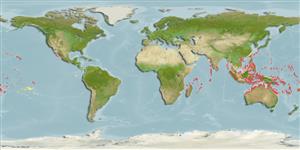Environment: milieu / climate zone / depth range / distribution range
Ökologie
seewasser riff-verbunden; tiefenbereich 3 - 20 m (Ref. 90102). Tropical; 30°N - 24°S
Indo-Pacific: East Africa to the Marquesan Islands, north to the Ryukyu Islands, south to northern Australia, New Caledonia and Rapa. Throughout Micronesia (Ref. 1602).
Size / Gewicht / Alter
Maturity: Lm ? range ? - ? cm
Max length : 24.0 cm TL Männchen/unbestimmt; (Ref. 4201)
Rückenflossenstacheln (insgesamt) : 11; Rückenflossenweichstrahlen (insgesamt) : 11 - 13; Afterflossenstacheln: 4; Afterflossenweichstrahlen: 7 - 9. Head and body silvery, scales often with blackish spot in centre (Ref. 4201). LL scales with pale red spot and black edges (Ref. 4201).
Found mainly around oceanic islands (Ref. 9710). It is an uncommon inhabitant of reef flats, lagoon and semi-sheltered seaward reefs to depths over 20 m. Occurs with N. sammara in coral-rich areas with large staghorn Acropora corals. Feeds mainly on benthic invertebrates (Ref. 11889).
Life cycle and mating behavior
Geschlechtsreife | Fortpflanzung | Ablaichen | Eier | Fecundity | Larven
Myers, R.F., 1991. Micronesian reef fishes. Second Ed. Coral Graphics, Barrigada, Guam. 298 p. (Ref. 1602)
IUCN Rote Liste Status (Ref. 130435: Version 2024-1)
Bedrohung für Menschen
Harmless
Nutzung durch Menschen
Tools
Zusatzinformationen
Download XML
Internet Quellen
Estimates based on models
Preferred temperature (Ref.
123201): 25.2 - 29.3, mean 28.4 °C (based on 2871 cells).
Phylogenetic diversity index (Ref.
82804): PD
50 = 0.5312 [Uniqueness, from 0.5 = low to 2.0 = high].
Bayesian length-weight: a=0.01950 (0.01214 - 0.03132), b=2.94 (2.80 - 3.08), in cm total length, based on LWR estimates for this species & (Sub)family-body (Ref.
93245).
Trophic level (Ref.
69278): 4.0 ±0.59 se; based on food items.
Widerstandsfähigkeit (Ref.
120179): hoch, Verdopplung der Population dauert weniger als 15 Monate. (Preliminary K or Fecundity.).
Fishing Vulnerability (Ref.
59153): Low vulnerability (14 of 100).
Nutrients (Ref.
124155): Calcium = 68.7 [31.1, 214.1] mg/100g; Iron = 0.693 [0.278, 1.457] mg/100g; Protein = 18.8 [17.6, 20.0] %; Omega3 = 0.159 [0.065, 0.380] g/100g; Selenium = 27.1 [15.3, 53.9] μg/100g; VitaminA = 82.9 [30.7, 235.8] μg/100g; Zinc = 1.27 [0.81, 1.98] mg/100g (wet weight);
